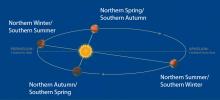Listen to today's episode of StarDate on the web the same day it airs in high-quality streaming audio without any extra ads or announcements. Choose a $8 one-month pass, or listen every day for a year for just $30.
You are here
Far From the Sun
Earth’s orbit around the Sun is a bit wonky. It’s a little stretched out, so our distance from the Sun varies. Over the course of a year, it changes by about three million miles — roughly three percent of the average distance. We’re closest to the Sun in January, and farthest in July. In fact, we’ll be at our most distant on Monday.
One consequence of the changing distance is that Earth moves at different speeds in different parts of its orbit. In January, when the Sun is closest, Earth moves a little faster than average. And now, we’re moving a little slower than average.
The change in speed affects the length of the seasons. Winter is the shortest season in the northern hemisphere, while summer is the longest. Summer will last almost 94 days — about five days longer than winter.
There’s also a difference in the length of a day — the time from one local noon to the next. When we’re closest to the Sun, a day averages a few minutes less than 24 hours. But now, when we’re farther away, a day averages a few minutes more than 24 hours.
Unless you go out and plot the Sun’s position from day to day, though, it’s nothing you’re likely to notice. We keep time with mechanical or digital devices. And with Daylight Saving Time, the time on the clock can vary from local solar time by up to a couple of hours.
So the rhythm of the Sun doesn’t always match the rhythm of daily life — regardless of how far away the Sun is.
Script by Damond Benningfield





